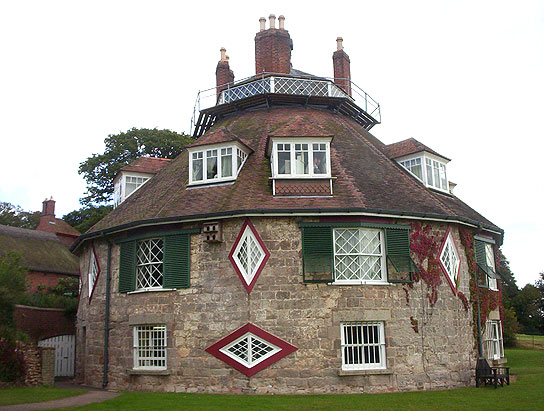
National Trust.
A unique sixteen-sided house, built for two spinster cousins after their return from a grand tour in the 18th century. It looks like something from a child’s imagination, and its cramped rooms contain large collections of curious objects. There is a feather frieze composed of feathers of many species of birds, and on the top floor is a shell-encrusted gallery, said to be composed of about 25,000 shells, which because of its fragility and problems of access has to be viewed by closed circuit television. Outside is a small garden, and there are great views of the Exe estuary.
Category: National Trust
Woolsthorpe Manor, Lincs.
National Trust.
Woolsthorpe is a modest manor house, noted as the birthplace of Sir Isaac Newton. The famous apple tree can still be seen from Newton’s bedroom window. I recollect that some period interiors are on display. There are also some exhibitions and science-related displays, and a short film about Newton.
It does not take very long to go round the house itself.
Waddesdon Manor, Bucks.
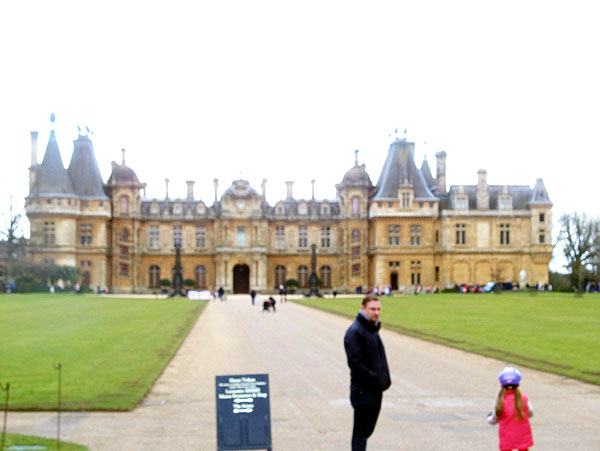 National Trust.
National Trust.
Waddesdon is one of several grand houses built by the Rothschilds (famous Jewish bankers). It was built in 1874-9 for Ferdinand de Rothschild, to a French design, and intentionally resembles a French Renaissance chateau. Ferdinand clearly dreamed of mansard roofs, pinnacles, massive chimneys, dormer windows and staircase towers. The pastiche chateau has similarly ornate French interiors, and Ferdinand was able to salvage panelling from the great Parisian houses demolished by Baron Haussmann to make way for the new boulevards. Needless to say, the furniture is also French. The rooms on the regular tour are full of treasures. The Batchelor’s Wing is not open at weekends, but contains smoking and billiard rooms, and even more treasures.
Outside, there is an entrance to the Rothschild wine cellars, some fine gardens and a wooded park. The formal parterre is to the south, and elsewhere is less formal well-planted parkland, the kind of terrain in which one can get lost trying to find the car park. There is a large 18th century style aviary housing exotic birds from over the world, and the grounds are dotted with contemporary sculptures.
With a total of 45 rooms on display, the visitor should allow enough time to see everything. At least a half-day visit is suggested.
As of Spring 2016, there is a large new hard-standing car-park on level ground, so that visitors no longer park on steep roadsides in the woods nearer to the house. The new car park is 15 minutes’ walk from the house, and free shuttle buses are provided.
Roadside signs and the free map indicate the way to Windmill Hill. This is not primarily a visitor attraction, but is the Rothchilds’ archive and conference centre. The buildings are an attractive set of Modernist structures set on a hilltop, on the site of the former Windmill Hill Dairy Farm, and complete with ornamental pool and modern sculptures, and a flat arch framing the view. The site is well worth a visit to snoop around the exterior and enjoy the architecture.
Canons Ashby, Northants.
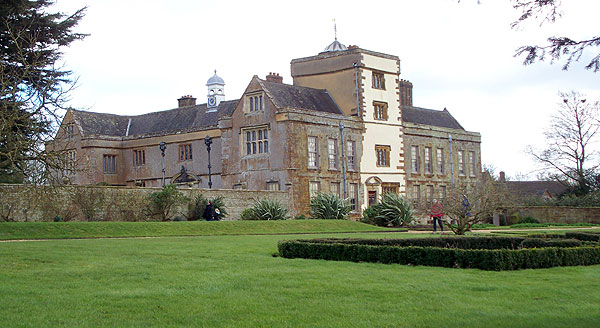 National Trust.
National Trust.
The house originated as a Tudor manor house and has been altered and extended over the centuries. It is built round a courtyard, whose rough and irregular walls are set with leaded windows, while a squat tower rises over the south front. The exterior of the house is mostly clad in handsome stone. A series of impoverished owners have made few changes since the 19th century.
The visitor enters across the courtyard and into the great hall. The drawing room upstairs is dominated by a massive Elizabethan fireplace, and has a domed plasterwork ceiling covered with carving and with a massive central pendant. Other notable rooms include the Painted Parlour, with trompe l’oeil decoration. The old kitchen, part of the cellars, and other service rooms can be viewed.
Now (2016) the Long Gallery is a through route, and two small rooms opening off it can be viewed. Descending to the Winter Parlour, one can visit two servant’s rooms en route.
Outside, the west side faces a grassy court, and the south side faces a formal garden of 18th century design. The house is set in an expanse of parkland.
A few dozen yards from the house, on the opposite side of the road, is a church, now reduced to a quarter of its original size, all that remains of the priory. Materials were taken from the demolished east end of the church to to build the H-shaped Tudor house.
When the NT acquired the house they had to take urgent action to prevent parts of it from falling down. Some old wall paintings uncovered during the works can still be seen upstairs. Services consisted of one cold water tap in the kitchen.
This is a charming old house which I have visited more than once. The gardens are also very pleasant.
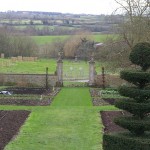
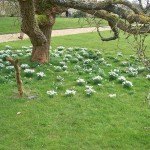
Rievaulx Terrace & Temples, Yorks
National Trust
The site is an artificial terrace of serpentine form, on a wooded escarpment overlooking the ruins of Rievaulx Abbey. Wide lawns are framed by banks of luxuriant flowers, and at either end of the terrace is a small temple. The Doric or Tuscan temple has flooring from the Abbey, and the Ionic temple at the other end was intended as a banqueting house and has elaborate interior décor. There is an exhibition in the Ionic Temple basement, in the former kitchen quarters. The terrace was constructed for Thomas Duncombe III, from the same family who owned Duncombe Park a mile away. Duncombe Park also has a formal terrace and temples, constructed earlier in about 1730.
The gardens are very pleasant, and worth a visit if you are touring in the area. Other attractions, e.g. Duncombe Park, Nunnington Hall, are nearby. In theory, the site overlooks the nearby Rievaulx Abbey below, but in practice the view (in 2005) is severly restricted by tree growth.
Ormesby Hall, Yorks.
National Trust
The hall is built of weather-stained stone in a notably plain Palladian style. Originally it was in open countryside but now the suburbs of Middlesborough have encroached on the estate. The two-story service wing on the east was formed out of the earlier Jacobean house. Inside, the interior of the main block, which has some rich plaster decoration and woodwork carving, is a complete contrast to the plain exterior. The service wing contains a fully equipped Victorian laundry. Outside, there is an attractive garden. The fine Georgian stable block is home to the horses of the Cleveland mounted police. A Model Railway group is based at the Hall in the old wing, with three permanent layouts on view.
I found that visiting the Hall was worth a rather tedious drive to reach it.
Hardwick Hall, Derbyshire
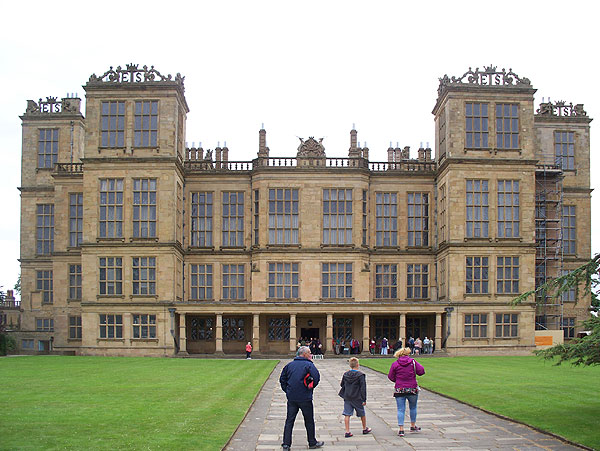 National Trust.
National Trust.
Hardwick Hall is one of the best-known of the NT houses. This Elizabethan house stands on a hilltop, looking big, smart, symmetrical and impressive. The tag “Hardwick Hall, more window than wall” was coined to describe it, and indeed it seems to have a window/wall ratio rather greater than that of my Victorian house and more typical of a public building. The design looks timeless owing to this particular look being copied in later centuries. Everything about the place seems calculated to impress by its size and grandeur. There are at least two big stone staircases, and on ascending one of them, one enters the High Great Chamber on the second floor. This is a very big and very high room and lavishly decorated, the Elizabethan decorations being largely unchanged. There is also a long gallery which is quite high and very long, and crammed with 80 portraits.
In the Dining Room the Sea-dog table is supported by four superbly carved chimeras and four tortoises.
The first floor rooms are now all open to visitors. The house has six towers incorporated in the structure, and atop the towers are the initials of the house’s first owner, Elizabeth Shrewsbury, in letters at least six feet high.
Close by are the ruins of Harwick Old Hall (English Heritage), which is in fact little older than the new Hall, but was allowed to fall into disrepair in more recent years.
Don’t miss a chance to visit. A visit to both Halls and their grounds will occupy several hours. Nearby on the Hardwick estate is Stainsby Mill (NT), a water-mill in working order. (revisited July 2017)
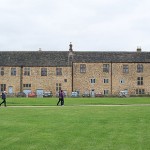
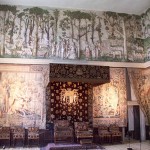
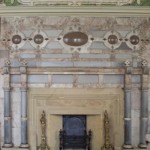
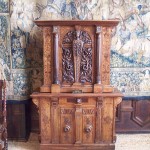
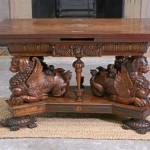
Fountains Abbey, Yorks.
National Trust & English Heritage
Fountains Abbey is now rated as a World Heritage Site. The abbey ruins are unusually complete, with many parts standing at near their original height. Perhaps the site was too remote to be extensively pillaged for building stone. There is much to see and do on site. Besides exploring the extensive abbey ruins, you can explore the beautifully landscaped Georgian water garden of Studley Royal, and visit Elizabethan Fountains Hall, the Cistercian monastery corn mill, and St Mary’s Church.
The gardens have a lake and many temples and follies, and even a twisting tunnel designed to give visitors a mild scare. If you are a fan of William Burges, do not miss the Victorian church, which looks plain on the outside, but inside is a riot of Victorian Gothic colour and carved ornamentation in wood and stone.
You should plan for an all-day visit.
Charlecote Park, Warwickshire
The long red-brick house, spiky with gables and chimneys, sits close to a ponded stream. Parts of the house date from the sixteenth century. The house is built on an irregular E-plan, and has Queen Elizabeth I’s coat of arms displayed over the porch. Though Charlecote looks like an Elizabethan mansion, most of it dates from the early nineteenth century. The nineteenth-century interiors are also finished in Elizabethan style. There is a fine collection of books, and some fine furniture.
Outside are outbuildings, some of them older than the house, including a brew-house, a wash-house, and a coach-house displaying a collection of vehicles used at Charlecote in the nineteenth century.
Beningborough Hall, Yorkshire
The great baroque house was built in the early 18th century. Notable are long vistas down the corridors, and the high quality of woodcarving on friezes and overmantels. The contents were dispersed in a 1958 sale, but some have been bought back since. The house also hosts a loan of 120 portraits from the National Portrait Gallery, and some porcelain from the Ashmolean Museum. Outside, a garden lies along the south side of the house.
